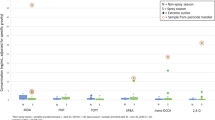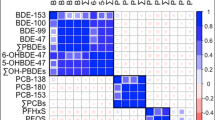Abstract
Organochlorine (OC) pesticide use was restricted starting in the 1970s in developed countries and the 1980s and 1990s in developing countries. Current exposure to OC pesticides — dichlorodiphenyltrichloroethane (DDT), lindane (99% pure gamma-hexachlorocyclohexane (γ-HCH)), hexachlorobenzene (HCB) — occurs on a limited basis. We measured para, para' (p,p′)-DDE, p,p′-DDT, ortho, para′ (o,p′)-DDT, HCB, beta (β)-HCH (the most persistent isomer of technical-grade HCH) and γ-HCH in serum from 426 low-income pregnant Latina women living in an agricultural community in California. Detection frequencies were 94% to 100%. Median levels (ng/g lipid) of p,p′-DDE (1,052), p,p′-DDT (13), β-HCH (37) and HCB (65) were significantly higher than United States population levels. Multivariate analyses of p,p′-DDE, p,p′-DDT, o,p′-DDT, β-HCH and HCB indicate that time spent living outside the United States and birthplace in an area of Mexico with recent use of OC pesticides were significant predictors of exposure. Time spent living in the United States was associated with increased serum levels of p,p′-DDE and β-HCH, but the increase for each year lived in the United States was lower than for each year lived outside the United States. There was no difference between the increase of HCB levels over time spent in or outside the United States, suggesting current and thus preventable exposure routes. However, we observed no associations between serum levels of any OC compound and current intake of saturated fat or agricultural take-home exposure risk factors. Lactation history and recent weight gain were negatively associated with serum levels of some, but not all OC compounds studied. Smoking history was borderline associated with elevated HCB levels. We observed no significant associations with body mass index. Although the weight of evidence from this study indicates that most exposure occurred before moving to the United States, the results for HCB indicate the possibility of ongoing exposure in this country.
This is a preview of subscription content, access via your institution
Access options
Subscribe to this journal
Receive 6 print issues and online access
$259.00 per year
only $43.17 per issue
Buy this article
- Purchase on Springer Link
- Instant access to full article PDF
Prices may be subject to local taxes which are calculated during checkout
Similar content being viewed by others
References
Ambrus A., Hamilton D.J., Kuiper H.A., and Racke D. Significance of impurities in the safety evaluation of crop protection products. Pure Appl Chem 2003: 75(7): 937–973.
Barr D.B., Barr J.R., Driskell W.J., Hill Jr R.H., Ashley D.L., Needham L.L., Head S.L., and Sampson E.J. Strategies for biological monitoring of exposure for contemporary-use pesticides. Toxicol Ind Health 1999: 15(1–2): 168–179.
Barr J.R., Maggio V.L., Barr D.B., Turner W.E., Sjodin A., Sandau C.D., Pirkle J.L., Needham L.L., and Patterson Jr D.G. New high-resolution mass spectrometric approach for the measurement of polychlorinated biphenyls and organochlorine pesticides in human serum. J Chromatogr B Analyt Technol Biomed Life Sci 2003: 794(1): 137–148.
Bradman M.A., Harnly M.E., Draper W., Seidel S., Teran S., Wakeham D., and Neutra R. Pesticide exposures to children from California's Central Valley: results of a pilot study. J Expo Anal Environ Epidemiol 1997: 7(2): 217–234.
CDC. 1999–2000 National Health and Nutrition Examination Survey (NHANES), Demographics and Lab 28 Dioxins data files. July 2005: http://www.cdc.gov/nchs/about/major/nhanes/nhanes99_00.htm.
Deutch B., Pedersen H.S., Jorgensen E.C., and Hansen J.C. Smoking as a determinant of high organochlorine levels in Greenland. Arch Environ Health 2003: 58(1): 30–36.
Dorea J.G., Cruz-Granja A.C., Lacayo-Romero M.L., and Cuadra-Leal J. Perinatal metabolism of dichlorodiphenyldichloroethylene in Nicaraguan mothers. Environ Res 2001: 86(3): 229–237.
DPR. Agricultural Sources of DDT Residues in California's Environment. Sacramento, CA: Environmental Hazards Assessment Program, California Department of Pesticide Regulation; September 1985.
DPR. Annual Residue Data, http://www.cdpr.ca.gov/docs/pstrsmon/rsmonmnu.htm#data(Accessed March, 2005 1986–2004).
Eskenazi B., Bradman A., Gladstone E.A., Jaramillo S., Birch K., and Holland N.T. CHAMACOS, a longitudinal birth cohort study: lessons from the fields. J Childr Health 2003: 1(1): 3–27.
Eskenazi B., Marks A.R., Bradman A., Fenster L., Johnson C., Barr D.B., and Jewell N.P. In utero exposure to dichlorodiphenyltrichloroethane (DDT) and dichlorodiphenyldichloroethylene (DDE) and neurodevelopment among young Mexican American children. Pediatrics 2006: 118(1): 233–241.
Farhang L., Weintraub J.M., Petreas M., Eskenazi B., and Bhatia R. Association of DDT and DDE with birth weight and length of gestation in the Child Health and Development Studies, 1959–1967. Am J Epidemiol 2005: 162(8): 717–725.
Fenster L., Eskenazi B., Anderson M., Bradman A., Harley K., Hernandez H., Hubbard A., and Barr D.B. Association of in utero organochlorine pesticide exposure and fetal growth and length of gestation in an agricultural population. Environ Health Perspect 2006: 114(4): 597–602.
Galvan-Portillo M., Jimenez-Gutierrez C., Torres-Sanchez L., and Lopez-Carrillo L. Food consumption and adipose tissue DDT levels in Mexican women. Cad Saude Publica 2002: 18(2): 447–452.
Glynn A.W., Granath F., Aune M., Atuma S., Darnerud P.O., Bjerselius R., Vainio H., and Weiderpass E. Organochlorines in Swedish women: determinants of serum concentrations. Environ Health Perspect 2003: 111(3): 349–355.
Harley K., Eskenazi B., and Block G. The association of time in the US and diet during pregnancy in low-income women of Mexican descent. Paediatr Perinat Epidemiol 2005: 19(2): 125–134.
Hornung R.W., and Reed L.D. Estimation of average concentration in the presence of nondetectable values. Appl Occup Env Hyg 1990: 5(1): 46–51.
ISAT. Nomination Dossier for Hexachlorobenzene, Instituto de Salud Ambiente y Trabajo, for North American Commission for Environmental Cooperation, Montreal, 1998 Available: http://www.cec.org/files/pdf/POLLUTANTS/hcbmex_en.PDF(Accessed: June 7, 2005).
Lackmann G.M., Angerer J., and Tollner U. Parental smoking and neonatal serum levels of polychlorinated biphenyls and hexachlorobenzene. Pediatr Res 2000: 47(5): 598–601.
Li Y.F. Global technical hexachorocyclohexane usage and its contamination consequences in the environment: from 1948 to 1997. Sci Total Environ 1999: 232(3): 121–158.
Lopez-Carrillo L., Torres-Sanchez L., Moline J., Ireland K., and Wolff M.S. Breast-feeding and serum p, p′DDT levels among Mexican women of childbearing age: a pilot study. Environ Res 2001: 87(3): 131–135.
Moysich K.B., Ambrosone C.B., Mendola P., Kostyniak P.J., Greizerstein H.B., Vena J.E., Menezes R.J., Swede H., Shields P.G., and Freudenheim J.L. Exposures associated with serum organochlorine levels among postmenopausal women from western New York State. Am J Ind Med 2002: 41(2): 102–110.
NACEC. History of DDT in North America to 1997. North American Commission for Environmental Cooperation, Montreal, 2001. Available: http://www.cec.org/files/PDF/POLLUTANTS/HistoryDDTe_EN.PDF(Accessed: June 7 2005).
Pardio V.T., Waliszewski K.N., Landin L.A., and Bautista R.G. Organochlorine pesticide residues in cow's milk from a tropical region of Mexico. Food Addit Contam 2003: 20(3): 259–269.
Perry M.J., Ouyang F., Korrick S., Venners S.A., Altshul L., Xu X., and Wang X. Body mass index and serum 1, 1, 1-trichloro-2, 2-bis(p-chlorophenyl)ethane in nulliparous Chinese women. Cancer Epidemiol Biomarkers Prev 2005: 14(10): 2433–2438.
Phillips D.L., Pirkle J.L., Burse V.W., Bernert Jr J.T., Henderson L.O., and Needham L.L. Chlorinated hydrocarbon levels in human serum: effects of fasting and feeding. Arch Environ Contam Toxicol. 1989: 18(4): 495–500.
Roberts D.R., Manguin S., and Mouchet J. DDT house spraying and re-emerging malaria. Lancet 2000: 356(9226): 330–332.
Rosenberg T. What the world needs now is DDT. New York Times Magazine. April 11, 2004. Available: http://query.nytimes.com/gst/health/article-page.html?res=9F0DEEDA1738F932A25757C0A9629C8B63.
Sarcinelli P.N., Pereira A.C., Mesquita S.A., Oliveira-Silva J.J., Meyer A., Menezes M.A., Alves S.R., Mattos R.C., Moreira J.C., and Wolff M. Dietary and reproductive determinants of plasma organochlorine levels in pregnant women in Rio de Janeiro. Environ Res 2003: 91(3): 143–150.
StataCorp. Intercooled Stata 8.2 for Windows. Stata Corporation. College Station, TX, 2004.
Torres-Arreola L., Lopez-Carrillo L., Torres-Sanchez L., Cebrian M., Rueda C., Reyes R., and Lopez-Cervantes M. Levels of dichloro-dyphenyl-trichloroethane (DDT) metabolites in maternal milk and their determinant factors. Arch Environ Health 1999: 54(2): 124–129.
U.S. DHHS. Clinical Laboratory Improvement Amendments (CLIA) of 1988. United States Code of Federal Regulations, Title 42 – Public Health; Chapter IV, Centers For Medicare & Medicaid Services, Department of Health and Human Services, Part 493 – Laboratory Requirements; Sections 493.1–493.2001: National Archives and Records Administration, College Park, MD. Available: http://www.access.gpo.gov/nara/cfr/waisidx_04/42cfr493_04.html.
U.S. DHHS. Toxicological Profile for DDT, DDE, and DDD. U.S. Department of Health and Human Services Public Health Service, Agency for Toxic Substances and Disease Registry, Atlanta, GA, 2002.
Waliszewski S.M., Aguirre A.A., Infanzon R.M., Lopez-Carrillo L., and Torres-Sanchez L. Comparison of organochlorine pesticide levels in adipose tissue and blood serum from mothers living in Veracruz, Mexico. Bull Environ Contam Toxicol 2000: 64(1): 8–15.
Wolff M.S., Deych E., Ojo F., and Berkowitz G.S. Predictors of organochlorines in New York City pregnant women, 1998–2001. Environ Res 2005: 97(2): 170–177.
Wooldridge J. Introductory Econometrics: A Modern Approach. South-Western College, Cincinnati, OH, 2000.
Yanez L., Ortiz-Perez D., Batres L.E., Borja-Aburto V.H., and Diaz-Barriga F. Levels of dichlorodiphenyltrichloroethane and deltamethrin in humans and environmental samples in malarious areas of Mexico. Environ Res 2002: 88(3): 174–181.
Acknowledgements
This research was supported by NIOSH (RO1-OH007400). Additional support was provided by USEPA grant number RD-83171001 and NIEHS grant number PO1-ES009605. Ideas expressed are the authors' and not necessarily those of CDHS, NIOSH, USEPA, CDC or NIEHS. All authors report no conflicts of interest regarding this manuscript. We thank the CHAMACOS staff, students and community partners for their contributions to this effort. We especially thank the CHAMACOS women for participating in this study.
Author information
Authors and Affiliations
Corresponding author
Rights and permissions
About this article
Cite this article
Bradman, A., Schwartz, J., Fenster, L. et al. Factors predicting organochlorine pesticide levels in pregnant Latina women living in a United States agricultural area. J Expo Sci Environ Epidemiol 17, 388–399 (2007). https://doi.org/10.1038/sj.jes.7500525
Received:
Accepted:
Published:
Issue Date:
DOI: https://doi.org/10.1038/sj.jes.7500525
Keywords
This article is cited by
-
Evaluating the fate and potential health risks of organochlorine pesticides and triclosan in soil, sediment, and water from Asa Dam River, Ilorin Kwara State, Nigeria
Environmental Monitoring and Assessment (2023)
-
Environmental neurotoxic pollutants: review
Environmental Science and Pollution Research (2020)
-
Prenatal β-Hexachlorocyclohexane (β-HCH) Exposure and 7-Year Child IQ in the CHAMACOS Birth Cohort
Neurotoxicity Research (2020)
-
Effect of environmental toxicants on neuronal functions
Environmental Science and Pollution Research (2020)
-
Phthalate metabolite exposures among immigrants living in the United States: findings from NHANES, 1999–2014
Journal of Exposure Science & Environmental Epidemiology (2019)



